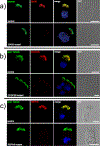European Respiratory Society guidelines for the diagnosis of primary ciliary dyskinesia
- PMID: 27836958
- PMCID: PMC6054534
- DOI: 10.1183/13993003.01090-2016
European Respiratory Society guidelines for the diagnosis of primary ciliary dyskinesia
Abstract
The diagnosis of primary ciliary dyskinesia is often confirmed with standard, albeit complex and expensive, tests. In many cases, however, the diagnosis remains difficult despite the array of sophisticated diagnostic tests. There is no "gold standard" reference test. Hence, a Task Force supported by the European Respiratory Society has developed this guideline to provide evidence-based recommendations on diagnostic testing, especially in light of new developments in such tests, and the need for robust diagnoses of patients who might enter randomised controlled trials of treatments. The guideline is based on pre-defined questions relevant for clinical care, a systematic review of the literature, and assessment of the evidence using the GRADE (Grading of Recommendations, Assessment, Development and Evaluation) approach. It focuses on clinical presentation, nasal nitric oxide, analysis of ciliary beat frequency and pattern by high-speed video-microscopy analysis, transmission electron microscopy, genotyping and immunofluorescence. It then used a modified Delphi survey to develop an algorithm for the use of diagnostic tests to definitively confirm and exclude the diagnosis of primary ciliary dyskinesia; and to provide advice when the diagnosis was not conclusive. Finally, this guideline proposes a set of quality criteria for future research on the validity of diagnostic methods for primary ciliary dyskinesia.
Copyright ©ERS 2017.
Figures




References
-
- Lucas JS, Leigh MW. Diagnosis of primary ciliary dyskinesia: searching for a gold standard. Eur. Respir. J 2014; 44: 1418–1422. - PubMed
-
- Barbato A, Frischer T, Kuehni CE, Snijders D, Azevedo I, Baktai G, Bartoloni L, Eber E, Escribano A, Haarman E, Hesselmar B, Hogg C, Jorissen M, Lucas J, Nielsen KG, O’Callaghan C, Omran H, Pohunek P, Strippoli M-PF, Bush A. Primary ciliary dyskinesia: a consensus statement on diagnostic and treatment approaches in children. Eur. Respir. J 2009; 34: 1264–1276. - PubMed
-
- Kuehni CE, Frischer T, Strippoli M-PF, Maurer E, Bush A, Nielsen KG, Escribano A, Lucas JSA, Yiallouros P, Omran H, Eber E, O’Callaghan C, Snijders D, Barbato A. Factors influencing age at diagnosis of primary ciliary dyskinesia in European children. Eur. Respir. J 2010; 36: 1248–1258. - PubMed
-
- Strippoli M-PF, Frischer T, Barbato A, Snijders D, Maurer E, Lucas JSA, Eber E, Karadag B, Pohunek P, Zivkovic Z, Escribano A, O’Callaghan C, Bush A, Kuehni CE. Management of primary ciliary dyskinesia in European children: recommendations and clinical practice. Eur. Respir. J 2012; 39: 1482–1491. - PubMed
Publication types
MeSH terms
Substances
Grants and funding
LinkOut - more resources
Full Text Sources
Other Literature Sources
Medical
